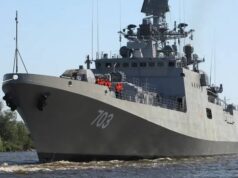Between 1987 to 1996, the Indian Ocean Region had got accustomed to seeing two Indian Navy aircraft Carriers prowling its waters. Most of the time even the US Navy did not have two Carrier Battle Groups in the IOR simultaneously.
Then bad planning set in together with fund crunch. In 1997, INS VIKRANT was decommissioned and INS VIRAT was set to retire in 2007.
Carriers are not only a floating, moving airbases but also assert influence over the Ocean region and help in power projection and persuasive diplomacy. So replacements were required at the earliest.
However India’s options were limited as only countries building carriers at the time were United States, France and Italy and price varied from $ 8 billion for a nuclear powered carrier to over $ 4 billions for a conventional one. Then there were political costs both overt and hidden, in addition.
In 2004, our old all weather friend Russia came to our rescue once again. A deal was struck in which India would receive Admiral Gorshkov as a gift but India would have to pay $974 million dollars to Russia to upgrade the Carrier.
This ship had been commissioned by Soviet Union in 1988 as Baku. She and her four sisters ships of Kiev class represented a unique Soviet design.
The front third resembled a heavy cruiser, with 12 giant SS-N-12 anti-ship missiles, up to 192 surface-to-air missiles and two 100-millimeter deck guns.
The remaining two-thirds of the ship was basically an aircraft carrier, with an angled flight deck and a hangar.
Baku had briefly served in the Soviet navy until the USSR broke up in 1991. Russia inherited the vessel, renamed her Admiral Gorshkov and kept her on the rolls of the new Russian navy until 1996.
After a boiler room explosion, Admiral Gorshkov went into mothballs due to severe fund crunch.
Now Russia was ready to transform the vessel from a helicopter carrier with a partial flight deck to an aircraft carrier with a launch ramp and a flight deck over 900 feet long.
At any rate it was a formidable refit task to up grade a 44,500 tons, a decade old,air craft carrier which had spent eight years in mothballs. New radars, new boilers, new arrester wires and new deck elevators would be fitted.
All 2,700 rooms and compartments—spread out over 22 decks—would be refurbished and new wiring would be laid throughout the ship. The hull work was completed by 2008 and VIKRAMADITYA was launched on 4 December 2008. Around 99% of the structural work and almost 50% of the cabling work had been completed by June 2010.
Almost all of the large equipment, including engines and diesel generators, was installed. A naval MiG-29K prototype aircraft was used to test the deck systems of VIKRAMADITYA in 2010. Then a major problem came up regarding the cable work and cost escalation.
Finally all reconfiguration work was completed after a delay of three years due to underestimation of the amount of cabling needed. An expert level discussion on technical and financial cost escalation was held between India and Russia to sort out the issues. India agreed to pay an extra amount and Russia agreed to install new systems instead of repairing the old ones.
Dock trials began on 1 March 2011 to focus on the main power generation units and the radio-electronic armament systems, manufactured in India. Indian Navy personnel began training on VIKRAMADITYA with effect April 2011. VIKRAMADITYA finally entered sea trials in August 2012 at a total price of around 2.5 billion dollars.
The sea trials lasted three months. The carrier’s electronic warfare and jamming capability was demonstrated when Sukhoi-33s, Kamovs, MiG-29s and A-50 early warning aircraft failed to “paint” the carrier using their radars, whereas the incoming aircraft were detected by the ship at a distance of 350–400 km. In total, the ship sailed for 19,500 miles during both the trials, controlled 778 aircraft and helicopter flights, and conducted 88 landings by Russian pilots. During the second sea trial, it sailed for 8,600 miles, of which 1,700 miles were under the command of the ship’s Indian captain Commodore Suraj Berry.
The ship was commissioned into the Indian navy in November 2013. Though when delivered, VIKRAMADITYA had yet to be fitted with any on-board armament. The air group and her powerful radars along with the escorts would take care of this. The ship also has chaff and flare systems to lure away anti-ship missiles. This armaments were fitted during the ship’s short refit of April–June 2015, when she was fitted with four license-built AK-630 CIWS, and a Barak 1 SAM system stripped from the decommissioned INS Godavari. During the ship’s first scheduled major refit in 2017, the Barak 1 system was replaced with the newly developed Barak 8 long-range air-defence system (LR-SAM) which is launched from vertical launch cells, and has an operational range of 0.5–100 km. The carrier carries up to 48 missiles.
The official expected life span of the ship is 40 years, and is unlikely to require any major repair work for at least a decade. Over 70% of the ship and her equipment is new and the remainder has been refurbished. Sevmash Shipyard, which upgraded the carrier, will provide warranty servicing including maintenance for the next 20 years.
Her air wing comprises 24 MiG-29K fighters and up to 10 Kamov helicopters, a formidable force against any other Asian or European Navy operating in the IOR. Even the US Navy would take such a Carrier seriously, especially when operating within the air cover of “ INS INDIA”. Though many “ Experts” have been trying to tarnish the image of this aircraft carrier, the same “ experts “ who have been idolizing the rust bucket Liaoning of the PLA NAVY.
After commissioning, VIKRAMADITYA had steamed ahead for 26-days continuously and travelled 10,212 nautical miles to INS Kadamba, at Karwar, from Severodvinsk.
It was received nearly 2,200 km away from Indian shores by a large flotilla of the Western fleet, comprising the aircraft carrier INS VIRAT, two Delhi-class destroyers, three Talwar-class frigates, the frigate INS Godavari, and a couple of offshore patrol vessels including INS Subhadra. The event was significant as the Indian Navy was operating two aircraft carriers simultaneously for the first time in 20 years. After conducting basic sea exercises with the fleet,[93] VIKRAMADITYA reached Karwar on 7 January 2014.
In May 2014, the carrier was declared operationally deployed along with its embarked air group comprising MiG-29Ks and had taken part in a war game conducted by the Western Naval Command. On 14 June 2014, Prime Minister of India dedicated the carrier to the country.
On 21–22 January 2016, VIKRAMADITYA accompanied by INS Mysore made her first overseas port visit when the ship visited Colombo in Sri Lanka, making the first visit of an Indian warship to the city in 30 years, and the first by an aircraft carrier in more than 40 years. On 15–18 February 2016, VIKRAMADITYA accompanied by two ships, INS Mysore and INS Deepak, made a goodwill visit to Male, Maldives.
Very Soon INS VIKRANT should be joining VIKRAMADITYA and then Indians will wait for INS VISHAL to be hopefully followed by three more carriers to give Indian Navy six Carrier Battle Groups.




